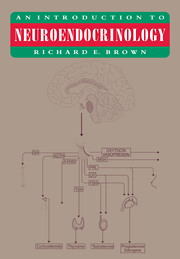Book contents
- Frontmatter
- Contents
- Preface
- Acknowledgements
- Illustration credits
- List of abbreviations
- 1 Classification of chemical messengers
- 2 The endocrine glands and their hormones
- 3 The pituitary gland and its hormones
- 4 The hypothalamic hormones
- 5 Neurotransmitters
- 6 Neurotransmitter control of hypothalamic, pituitary and other hormones
- 7 Regulation of hormone synthesis, storage, release, transport and deactivation
- 8 Regulation of hormone levels in the bloodstream
- 9 Steroid and thyroid hormone receptors
- 10 Receptors for peptide hormones, neuropeptides and neurotransmitters
- 11 Neuropeptides I: classification, synthesis and colocalization with classical neurotransmitters
- 12 Neuropeptides II: neuropeptide function
- 13 Cytokines and the interaction between the neuroendocrine and immune systems
- 14 Methods for the study of behavioral neuroendocrinology
- 15 An overview of behavioral neuroendocrinology: present, future and past
- Appendix Journals in endocrinology, neuroendocrinology, psychoneuroimmunology and behavioral endocrinology
- Index
10 - Receptors for peptide hormones, neuropeptides and neurotransmitters
Published online by Cambridge University Press: 26 December 2009
- Frontmatter
- Contents
- Preface
- Acknowledgements
- Illustration credits
- List of abbreviations
- 1 Classification of chemical messengers
- 2 The endocrine glands and their hormones
- 3 The pituitary gland and its hormones
- 4 The hypothalamic hormones
- 5 Neurotransmitters
- 6 Neurotransmitter control of hypothalamic, pituitary and other hormones
- 7 Regulation of hormone synthesis, storage, release, transport and deactivation
- 8 Regulation of hormone levels in the bloodstream
- 9 Steroid and thyroid hormone receptors
- 10 Receptors for peptide hormones, neuropeptides and neurotransmitters
- 11 Neuropeptides I: classification, synthesis and colocalization with classical neurotransmitters
- 12 Neuropeptides II: neuropeptide function
- 13 Cytokines and the interaction between the neuroendocrine and immune systems
- 14 Methods for the study of behavioral neuroendocrinology
- 15 An overview of behavioral neuroendocrinology: present, future and past
- Appendix Journals in endocrinology, neuroendocrinology, psychoneuroimmunology and behavioral endocrinology
- Index
Summary
Peptide hormones, neuropeptides, neurotransmitters and other non-steroid chemical messengers stimulate biochemical activity by binding to receptors on the plasma membranes of their target cells. These chemical messengers cannot enter their target cells to stimulate the nucleus in the manner described for steroid and thyroid hormones in Chapter 9. In order to activate biochemical changes within the target cell, they act as first messengers to activate a second messenger, such as cyclic adenosine monophosphate (cyclic AMP), within the cytoplasm of the target cell. The transduction of information from the first to the second messenger is accomplished through the activation of membrane protein transducers (G-proteins) and enzymes, such as adenylate cyclase. This chapter examines the membrane receptors for peptide hormones and neurotransmitters, the mechanisms by which signal transduction across the cell membrane occurs, the role of G-proteins in this signal transduction, the second messenger systems activated, and the actions of the second messengers in the target cells, with special emphasis on neural target cells.
MEMBRANE RECEPTORS
The membrane receptors are complex glycoproteins embedded in the cell membrane. The function of these receptors is to recognize specific ligands in the blood (e.g. peptide hormones, neuropeptides) or in the synapse (e.g. neurotransmitters) and bind to them. Once this binding occurs, signal transduction across the cell membrane occurs as described in Section 10.2 below. Using a number of pharmacological and biochemical techniques employing radioactively labeled ligands, fluorescent dyes, affinity chromatography and immunochemical identification, it is possible to discover the location and structure of the membrane receptors (see Limbird, 1986; Yamamura, Enna and Kuhar, 1990).
- Type
- Chapter
- Information
- An Introduction to Neuroendocrinology , pp. 191 - 220Publisher: Cambridge University PressPrint publication year: 1994



